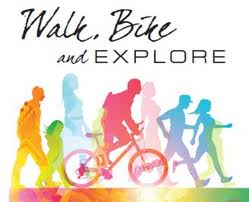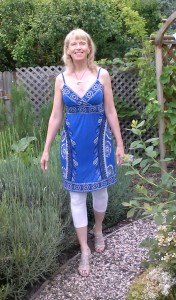If you’re sitting reading this you probably have, like me, some degree of Sitting Disease (SD). The bad news is that it lowers our resiliency and our quality of life, and costs our nation billions per year in extra medical costs. 
But the good news is that Sitting Disease has lots of cures, immediate ones. Many of them cost little or nothing, like many things that create high quality of life. (Remember, Diamond-Cut Life is about growing our joy, no matter our income level.)
I’m writing this at Bipartisan Café in Southeast Portland’s Montavilla neighborhood. My bicycle that I used to get here is parked in a bike corral that replaced a car space. The bike corral is already half-full at 7:15 in the morning. Bicycling the 1.5 miles here was ten times more fun than using the car, and was another small victory in my battle against Sitting Disease.
For almost all of human history, there was no Sitting Disease. Sitting Disease comes from our human inventions, especially the car, television and computer. Specifically, it comes from our choosing those things at the expense of being physically active.
Curing our Sitting Disease by being physically active doesn’t mean we become hardbodied athletes who play sports. It just means using our bodies, which means we actually become more self-sufficient. Our current culture has invented activity out of our lives. Inventing activity back into our lives builds our capacity to deal with climate change and other disruptions like extreme weather. See my review of Sharon Asyck’s book “Making Home” for more about thriving on our planet’s diminishing resource base.
Here are some cures for Sitting Disease. I’d also love to hear from you about more cures.
- Walk, rather than drive, to things within walking distance. Use this Walkscore site to find good walking destinations from your home, work or school address.
- Use transit instead of driving, if possible. Studies show that transit users take 30% more walking an people using cars.
- Use stairs instead of elevators or escalators. I do this whenever I’m in the Portland airport. It always surprises me that my husband is the only other person using the stairs. If I have to use an escalator, I climb it.
- Get a pedometer and wear it to count, and then increase, the steps you take each day. They’re low-cost, often free from Kaiser, and are quite motivating. (I personally multiply any uphill steps by two in my counting).
- Make short trips by bicycle. If you haven’t ridden in awhile, start very small. Dust off your bicycle, oil its chain and gears, take it just down the block and back. Work up to errands, and then try a commute-trip. You’ll love the way bicycling makes you feel: deeply alive and alert.
- Use a push-mower instead of a motorized lawn-mower. This doesn’t just give you a workout, it also reduces the air pollution you and your neighbors are breathing. It reduces noise pollution too, making your neighborhood a more inviting place for walkers, bicyclists and the kind of neighborly-style visiting that builds community.
- Walk the dog, or your child. Don’t just watch the dog or child walk.
- Put your television on a diet. Use the time this frees up to clean or organize a part of your house, or to garden or do yardwork. The results of your project will make you feel good. And anything that uses your body is a cure for Sitting Disease.
I work in transportation (rural transit), and I attended Oregon’s excellent Active Transportation Summit (OATS) in Salem this past week. I got the below information from a presentation by Angela Camilleri and Dr. Thomas Syltebo, both of Kaiser Permanente.
- Physically active people have 27% lower medical costs than inactive people. ,
- The medical cost of inactivity is second only to the medical cost of tobacco – and inactivity is drawing even with tobacco.
- Our overall health status is determined 40% by our personal choices and behaviors, including how physically active we are. Only 10% of our health status is determined by the medical care we receive. (As with all statistics, the data doesn’t apply to individual people, but to large groups of people.)
What is your own favorite way to overcome Sitting Disease and be physically active? Comments here.


April 28, 2013
Al,
Thanks for reminding us to be more active. One of the downsides of technology is that it tends to keep people sitting inside their home rather than exercising.P
Walking. Jogging. Biking,
and riding waves are at the top of my list.
April 30, 2013
Mick, I’ve been impressed with the way you’ve embraced walking, jogging and biking in the last decade. And riding waves, well, that has its roots in our shared childhood, when Mom and Dad used to take us to the beach. I agree that technology has downsides . . . I’ve always tried to be a critical consumer of it.
April 30, 2013
Hi Alison, Thank you for the very helpful information on Sitting Disease. My name is Emily Bright and I work for company called VARIDESK. We are also trying to help people combat Sitting Disease by educating the public of its affects and by using our low cost product VARIDESK, the Original Height Adjustable Desk! I’d love to discuss our product with you some more! You can learn more and read some of the articles we’ve published about sitting disease at our blog here: http://www.blog.varidesk.com I hope to speak with you soon!
April 30, 2013
Emily, Thanks for coming by and sharing. I visited the Varidesk blog just now, and liked the posts I saw. The infographics on Sitting Disease were really good. I would have liked to leave a comment — but comments were closed, same with the other posts. And there were no comments on any of the posts. At any rate, I can see that standing at a desk rather than sitting at it is, yes, another way to fight Sitting Disease.
May 5, 2013
Great article, as usual!
I don’t tend to feel massively motivated by the idea of just ‘going for a walk’, but I do feel motivated to walk ‘to’ something in particular. So, I just arrange plenty of activities that really motivate me that are outside the house.
I don’t have a car, so what I usually do is walk to wherever I’m going and then take public transport home if it’s late or I’m tired from all that walk there.
I walked back from the coach terminal today (1 hour). I contemplated a bus or taxi, but then realised my body would probably like a bit of extended movement, after being cooped up for 3 hours.
I would agree with you about starting slowly. I would also add that it’s about being yourself, the most increasingly active version of yourself. I’m not sure many people have the willpower to simply sustain being active for active’s sake, but if you build your life around your loves, it’s easy and natural, and very much energy-increasing.
May 5, 2013
Dani, I love what you said: “It’s about being yourself, the most increasingly active version of yourself”. It ties in with my belief that we’re all evolving, rather than static or inert. Thumbs up also on the idea of building our lives around what we love — doing this DOES increase our energy. At the same time, many people must work long hours for a living at unpleasant work nobody could love. I’ve had jobs I disliked; it’s a pretty universal experience. I think it’s in these life-situations that we need more than ever to be physically active, to reduce our stress and keep ourselves in balance. Unfortunately, more typical ways to deal with stress are watching TV, playing video games, surfing the Internet and going places via car — all of which contribute to Sitting Disease. It takes conscious effort to be healthy in our current culture. It’s a real swimming against the tide. Thanks for your good comment, Dani.
May 9, 2013
I’ll add one, from personal experience, to your list …
Find ways that combine physical activity with need-to-do’s.
Example: Today I combined a run with an important errand to mail off a light package (it needed to be next-day express). That meant I ran with the envelope for the first part of the run, and had to figure out where to stash my money (in a tiny pocket). But the small inconveniences were worth it. Instead of a 20-minute errand in the car, I enjoyed a 45-minute jog out in the sun, and nixed the errand off the list, too.
May 9, 2013
Colleen, I see what you’re describing, i.e. using our bodies for transportation, as the ideal cure for Sitting Disease. It’s the way people lived for most of human history, and it kept obesity at bay, as well as minimizing the many health problems that obesity brings.
On the positive side, it flat out feels good to move around in the sun for 45 minutes as you did today! And yes, it often takes some problem-solving, like running with the envelope in hand, and figuring out where to put your money. Thanks for sharing your story. Sitting Disease has little toehold in your or Thad’s life.
May 9, 2013
Treadmill desk! Treadmill desk! Want want want!
May 10, 2013
Ami, I was just thinking of you yesterday, hoping to hearing from you again. I’m smiling now, to learn that you’re wanting a treadmill desk. I hope your desire for movement gets satisfied, whether through a treadmill desk or through something else. Sometimes satisfaction can take unexpected forms.
May 11, 2013
Hi Alison,
I think you made a valuable point about the unpleasant work that people must do at certain times in their life. Interestingly, since you wrote that I have accepted a job myself that is not what I would necessarily choose if circumstances were different. However, I have taken it for love, and I can also predict some of the personal lessons I will learn through this work, and I’m sure there’ll be many others that I can’t predict.
We’ll see how I can keep my active self around..I hope it might be through getting a bike. The job is in Germany and they do seem to have great provision for cylists there.
I’m pretty sure I’ll be commenting on future posts. I do really enjoy your blog!
May 12, 2013
Dani, what exciting news, that you’re moving to Germany to take a job there, a “job for love”. My housemate Dan (who gardens in exchange for rent) lived in Germany for years, until just recently. He’s eager to return; he loves the German culture. Dan was car-free there, using the transit system and also doing lots of walking. I agree that you’ll learn a lot in your next life chapter . . . I hope to be hearing about it as you visit Diamond-Cut Life again.
January 22, 2014
Hi there! LOVING your site! I had to jump on this post because it was motivating to me. Previously I was always busy, running from here to there, but since my 2nd child started elementary and I’ve been home full time to write…I have acquired sitting disease big time! I’ve gained weight, and my back is always hurting - NO FUN. My kids’ school is only a mile away. You’ve motivated me to start walking/biking to pick them up instead of driving. That’s a start for sure. And I’ll walk my poor dog more consistently. Baby steps, but at least in the right direction.